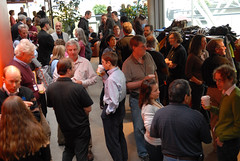
advocates all came together for
the 2010 Oregon Bike Summit.
– Photo Gallery –
(Photos © J. Maus)
The Oregon Bike Summit happened on Friday. It was a lot of excellent information packed into one day, without a lot of breaks. That meant it was difficult for me to simultaneously attend, listen, talk with people, photograph, and create coherent stories on the day of the Summit (especially since I left before it was over to see my 7 year-old daughter in a school performance). I did a few stories, but there’s much more to report.
“”Vehicular homicide will be an extremely heavy lift.”
— Doug Parrow, Chair of BTA Legislative Committee
On that note, I want to share some thoughts from the various speakers and workshops that happened throughout the day. If you attended, feel free to share your memories and insights in the comments.
Jonathan Nicholas was the emcee. He opened things up with his usual poetry-laden takes on the state of things in our local bicycling world. Here are a few notable ones:
“Some see the BTA as facing a precipice, I see it as a doorway, a portal to a golden tomorrow, the Golden Age of Bicycling in Oregon… If it does not happen here then where? If it does not happen now then when?
Nothing makes me more upset than to watch what’s going on in New York City and to think that Manhattan is ahead of Portland… we should be deeply ashamed.”
The BTA’s top legislative thinker, Doug Parrow, shared insights into the direction they’re headed for the 2011 session. I didn’t get down as much of his presentation as I would have liked, but I got a few nuggets. Parrow said the BTA’s legislative package will focus on personal safety and health and he spoke about the urgent need to more effectively make the case for bicycling to our state representatives in Salem. One of misperceptions he’s working to correct is that people who ride bikes don’t pay their way. One pillar of his argument is that, due to dwindling gas tax revenue, Oregon has jacked up a number of “fixed fees” like vehicle title and registration, that all car owners pay.
Parrow also touched on efforts to bring a tough vehicular homicide law to Oregon. From his comments, it seems like it’s not a given the BTA will go for it.
“Vehicular homicide will be an extremely heavy lift. We’re trying to identify a politically viable way to ratchet up the liability when someone kills someone else with their car.”
One shocking statistic Parrow shared was that in Oregon each year, 40,000 people are convicted of driving with a suspended license.
On the bike tourism front, we heard from Kristin Dahl of Travel Oregon. She gave an overview on the impact bicycling has on our state’s tourism revenue. Turns out that Oregon has twice the national average (percentage-wise) of people who ride a bike during their visit. According to Travel Oregon, in 2006 1.7 million overnight visitors biked while in Oregon.
Dahl also pointed out the big successes we’ve had in Oregon with mountain biking. “We have a competitive advantage on mountain biking.” She shared a few reasons Oregon is well-positioned for mountain (and road) biking: We’ve got only 36 people per square mile, a population density well below the national average of 86 (which ranks us 39th); and over half of our lands are publicly owned.

bike advocates to become
health advocates.
We also heard from Dr. Philip Wu from Kaiser Permanente. His presentation focused on the extent of the obesity epidemic and how bike advocates should focus on health and physical activity as a rallying point to promote more active transportation infrastructure.
“Human disease is preventable and physical inactivity is a major culprit.. health care costs are unsustainable… and cycling should be part of every day life.
…You should use the health message as a leverage point to broaden your appeal and accomplish your goals.”
Stressing that “transportation policy is health policy, Wu shared an interesting graphic…
With the above diagram on the screen behind him he said, “You can’t work on any one of these bubbles without touching every one of the other bubbles; and you’re just one degree removed from each of them.”
Wu said it’s a “daunting” prospect for advocates, but that it’s also encouraging to know there so many other potential allies which should be leveraged. Bike advocates, he said, must do more to partner with public health advocates and agencies.
After the general session talks, I sat in on several of the panel discussions. PBOT bike coordinator Roger Geller presented during a panel on active transportation. I’ve seen Geller present many times, but on Friday he had a new perspective — it was titled, Bicycling as if our future depends on it.
Since the Oregon Bike Summit is held in part to educate and train people from around the state to be more effective advocates, Geller’s talk focused on how bicycling can be positioned in a way that jibes with the “values and beliefs of people throughout the state, if not the country.”
“What’s important is that this is not about the bike; it’s about the future well-being of our citizens, our communities, and our world.”
Geller’s presentation made the case for biking on several fronts; personal safety, health, financial security, time (having and saving), children, and “intergenerational responsibility” (handing over a nice planet for our kids).
He showed a slide of kids on bikes and said,
“In Portland, these kids are four times safer than they were in 1996 because we built a bikeway system… Portland’s six-fold increase in bicycling since the early 1990s has saved lives and prevented injuries.”
This was also the most pointed I’ve seen Geller in talking about the deleterious impacts of motor vehicles in our city. He pointed out a recent study that showed people who live within 300-500 meters of a busy street are at a significantly greater risk of a host of illnesses. Check out his slide of how those impact corridors overlay with a map of Portland:
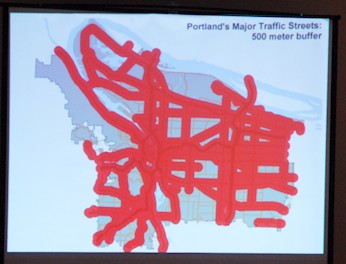
To tout PBOT work in making those street less busy, Geller pointed out their on-street bike parking program: “We’ve removed over 90 car spaces and put in 950 bike parking in commercial districts.”
Up next after Geller was the person behind Metro’s Active Transportation Partnership, Lake McTighe. She maintains that the biggest barrier to building out the active transportation network in our region is funding. At our current funding levels, McTighe says the estimated date of completion of that network is 2198.
Of all the transportation investments made in Portland over the past 15 years, only 2% of it has gone to active transportation projects (that’s about $191 million out of $9.2 billion). To put it in another perspective, the annual transportation investment in our region is $630 million, and currently we’re investing about $12 million of that into active transportation projects. That’s not enough money said McTighe because the Eastbank Esplanade alone cost $30 million.
The cost of the system Metro and others want would cost about $1 to 2 billion. To build all the biking and walking specific projects in Metro’s Regional Transportation Plan it would cost $1.3 billion. To build 340 miles of currently identified regional trails it will cost $1 billion.
That sounds like a lot of money, but McTighe said if the will was there, it could happen. To back up that claim, she pointed out the 46,000 miles of roads in our Interstate Highway System which were built in just 35 years at a cost of $425 billion. “Focused investments can get the system built.”
I sat in on one other workshop session, but I’ll save those notes for a separate post. I’ve also got notes from the talk at the end of the Summit by newly hired BTA Executive Director Rob Sadowsky, but I’ll wrap that into a separate story as well. And yes, I also have all the Big Ideas to share! I’m running out of time today, so stay tuned for more on those tomorrow.
To round out the Oregon Bike Summit coverage, if we’re going to build the kind of political and public will to spend real money on active transportation in Oregon, we’ve got to do more to build the constituency. On that note, the man who has single-handedly made the Summit happen each year, Cycle Oregon’s Jerry Norquist challenged all of us to make the 2011 summit the biggest yet.
The 2011 Oregon Bike Summit will be in Salem during next year’s legislative session. To make the kind of impact we need, Norquist said each one of us in the crowd should get 25 people to join them. “If we go to Salem with over 2,000 cyclists, we’ll make a big difference.”
— Read my other posts from the Oregon Bike Summit here (also see my story on OTC Chair Gail Achterman, which I published prior to the summit).

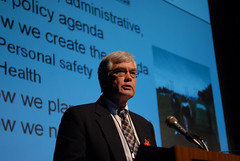
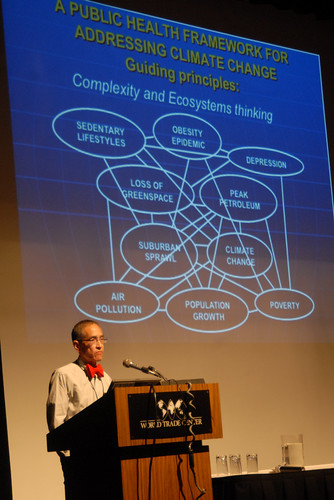
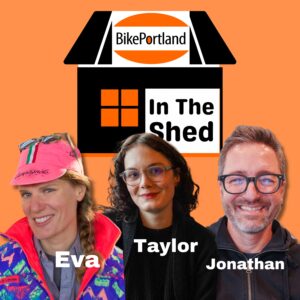
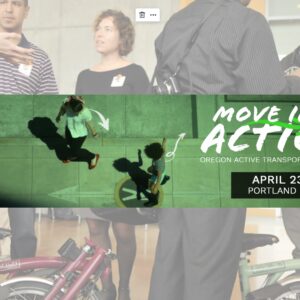
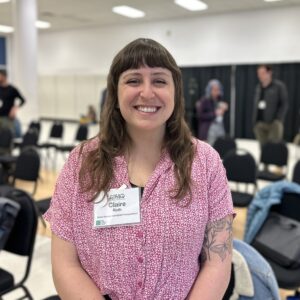
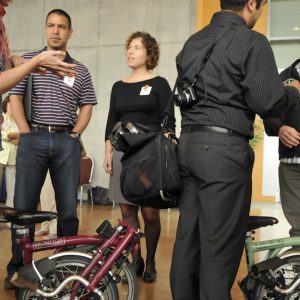
Thanks for reading.
BikePortland has served this community with independent community journalism since 2005. We rely on subscriptions from readers like you to survive. Your financial support is vital in keeping this valuable resource alive and well.
Please subscribe today to strengthen and expand our work.
Thanks Jonathan for this informative recap.
One good way to get more cyclists for 2011 would be if the Oregon Bike Summit organizers planned a public session that did not include any refreshments of any kind, and allowed people to attend just that part for $10, while charging the regular fee to full conference attendees. For an event like this, you want to set the bar low to get a lot of people involved. Bringing in a big-draw speaker for that session would help, too – like Earl Blumenaur.
This year’s conference had some great speakers, and I look forward to seeing what’s on tap for next year!
Thanks for all the news. Sorry you weren’t able to do twenty things at once. Im glad you got attend your childs function.
Keep us posted on the meeting in Salem for representation.
With all due respect to Jonathan Nicholas, I think we should be thrilled rather than ashamed that NYC is making such incredible strides. That’s an encouraging sign. And we here in PDX should feel challenged to keep pace…
Bikieboy,
what we should be ashamed of is that we are not taking steps anywhere nearly as bold as they are to reclaim space for people. We still have a measly few tenths mile of cycle track (NYC has five miles!) and we have not opened any new spaces downtown as walking only plazas. Portland needs to step up and become THE leader in making a city for people first and for moving and parking private cars second.
…but in a friendly, diplomatic way!
That was my big take-away from the summit.
‘You can lead the camel to water, but you can’t make it drink’ – Let’s make them think it’s our best NW brew!
We just have to convince drivers that it is good for them, too!
– that it is all of us, not our transportation-induced sub groups.
– and whip out the balance sheets with big figures when costs are mentioned!
I don’t think we’re going to get very far unless or until we change those key statistics that Lake McTighe presented. We need to focus on developing the political will to spend transportation dollars on active transportation projects to a much greater degree than currently exists. People are tired of what they, rightly or wrongly (and I think sometimes it is a little bit of both), see as funding sleights-of-hand that our politicians seem to embrace. The push-back against the City Council’s plan to re-prioritize BES spending for bike infrastructure investment is a perfect example. Property owners see their water & sewer bills going through the roof, then they hear that storm water management is somehow being tied to bike lanes, and voila — push back. It’s not that the plan doesn’t make sense and save money over time, it’s that there’s no political will here to say, “These are our transportation priorities — PBOT is going to devote more of its dollars to active transportation infrastructure, and here are the reasons why that makes sense.” Instead we get “We’re going to kick-start the Bike Master Plan with sewer money!.”
We should focus less on what NYC is accomplishing and more on how it is accomplishing it. NYC transportation officials and advocates are not pussyfooting around with funding tricks or mixed messages about what they want to accomplish. They are going to community boards and business associations with a clear, direct, consistent message. And yes, they do get push-back, but they mostly overcome it head-on. They have advantages in a critical mass of citizens who don’t drive regularly, and a population density that makes active transportation projects easier to implement. But we have a populace that cares about safety, health, and the environment, and those people can be reached, if our political leaders had the courage to do so without resorting to what sounds like funding tricks.
Jonathan, i agree with you — but it also seems to me that NYC has more amenable raw ingredients to cook with: a very dense urban environment, lots of people on the street/walking, and a huge amount of road space that’s been claimed by the auto.
That’s not an excuse for Portland not to be as bold or bolder in reclaiming people-space, but a natural advantage. You’re welcome to tell me I’m wrong because I haven’t spent all that much time in NYC, but just the way it seems to me based on my small experiential sample size…
And Michael M, i agree with your point about the “how” rather than the “what”.
Why is Vehicular Homicide .. an extremely heavy lift?
This seems like the basic civic foundation that all the other fluff can then be hung on.
Otherwise, so what if there is 212 miles of cycle track, green bike boxes in front of every Starbucks and 70% of all children riding to school?
Where can I read about dissenting views such debate?
re comment 9, i could not agree more: we would not “need” all this paint if we could cause motorists to slow down and pay attention, and get them off the roads when they fail to do this. doesn’t have to be criminal responsibility, though that is one tool. what makes it a “heavy lift” is that if juries are reluctant to convict, prosecutors will be reluctant to prosecute and police will be reluctant to charge. there is a huge cultural shift that needs to occur. right now, when you try to charge manslaughter on inattentiveness, the jury thinks, that could have been me. take a look at the prosecutor’s statement summarizing the grand jury’s decision not to charge the trimet driver in those pedestrian fatalities last month:
http://bikeportland.org/wp-content/uploads/2010/05/da_report_trimet.pdf
matt picio #2: Earl Blumenauer, you mean the guy that was succesful in closing 110+ miles of singletrack to bicycles in the Mt Hood area? That was over 54% of the trails we could ride, and maintained, for over two decades. His success at getting his Mt Hood Legacy Wilderness Act approved set bicyclists back about….2 decades. I approached him at the Bike Summit a few years ago, mentioned how concerned MTBers were about losing access to these awesome trails. His response? Nothing.
You know who is never going to get my vote no matter how ‘bike friendly’ he says he is.